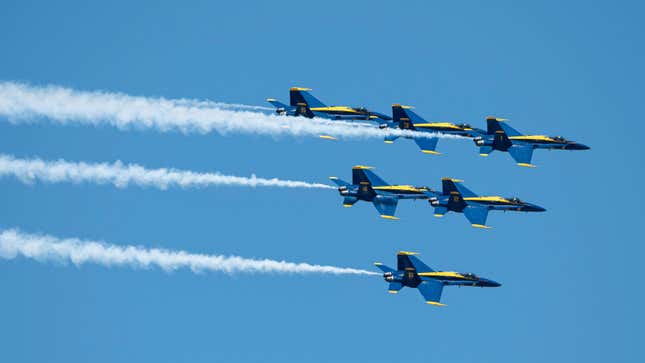
The Blue Angels may have to change up their routine at their next show. An investigation by the Seattle Times shows that the long-running military-backed air show squadron caused thousands of dollars in damages to a California naval base by performing a signature part of their routine.
The Blue Angels are known for doing their sneak pass maneuver at airshows across the country, and they’ve done it for years. I personally think it’s one of the greatest things ever, but I’m a huge kid. The sneak pass is a fast, low altitude maneuver that involves a plane flying just a few hundred feet above the ground approaching from the opposite way the crowd at the show thinks they are going to come from. It usually startles people, and that’s usually the point.
This particular instance, per the Seattle Times, involved a training exercise at the El Centro Naval Air Facility. On January 21, 2021, the Blue Angels conducted a sneak pass practice run over a particular set of buildings and personnel on the base. The pilot veered slightly off his intended course resulting in the pilot being within just 100 feet of the buildings. Witness statements say the resulting fly-by ripped tiles and roofing from nearby buildings and was strong enough to dislodge walls that were supposed to withstand earthquakes. People nearby suffered ringing ears and headaches. So what went wrong?
Simply put, the plane was too low, too damn fast, and too powerful. See, the Blue Angels hadn’t used that exact plane before. Starting last year, the squadron switched to F/A18 Super Hornets from regular F/A 18 Hornets. An investigative analysis done after the incident by the Naval Air Warfare Center Aircraft Division found that the Super Hornet created a larger sonic airflow than the previous Hornet. This sonic airflow can create a shockwave that can reach the ground and damage buildings or people. The investigation also found pilot error.
The pilot was supposed to follow a path that would put the plane within 500 feet of the crowd line at a speed of almost 725 mph. Instead, the pilot was 82 feet inside the crowd line going nearly 20 mph faster. This only caused the sonic airflow to increase, which caused more damage. The pilot didn’t even learn of the damage until after he landed, calling the pass “unremarkable” from inside the cockpit. While the Navy’s investigative report is extensive, there’s nothing in it that touches on any kind of disciplinary action for the pilot.